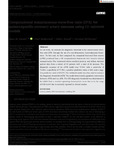Computational instantaneous wave‐free ratio (IFR) for patient‐specific coronary artery stenoses using 1D network models
| dc.contributor.author | Carson, JM | |
| dc.contributor.author | Roobottom, C | |
| dc.contributor.author | Alcock, R | |
| dc.contributor.author | Nithiarasu, P | |
| dc.date.accessioned | 2021-11-04T10:34:25Z | |
| dc.date.issued | 2019-11 | |
| dc.identifier.issn | 1069-8299 | |
| dc.identifier.issn | 2040-7947 | |
| dc.identifier.other | e3255 | |
| dc.identifier.uri | http://hdl.handle.net/10026.1/18210 | |
| dc.description.abstract |
<jats:title>Abstract</jats:title><jats:p>In this work, we estimate the diagnostic threshold of the instantaneous wave‐free ratio (iFR) through the use of a one‐dimensional haemodynamic framework. To this end, we first compared the computed fractional flow reserve (cFFR) predicted from a 1D computational framework with invasive clinical measurements. The framework shows excellent promise and utilises minimal patient data from a cohort of 52 patients with a total of 66 stenoses. The diagnostic accuracy of the cFFR model was 75.76<jats:italic>%</jats:italic>, with a sensitivity of 71.43<jats:italic>%</jats:italic>, a specificity of 77.78<jats:italic>%</jats:italic>, a positive predictive value of 60<jats:italic>%</jats:italic>, and a negative predictive value of 85.37<jats:italic>%</jats:italic>. The validated model was then used to estimate the diagnostic threshold of iFR. The model determined a quadratic relationship between cFFR and the ciFR. The iFR diagnostic threshold was determined to be 0.8910 from a receiver operating characteristic curve that is in the range of 0.89 to 0.9 that is normally reported in clinical studies.</jats:p> | |
| dc.format.extent | e3255- | |
| dc.format.medium | ||
| dc.language | en | |
| dc.language.iso | en | |
| dc.publisher | John Wiley and Sons | |
| dc.subject | coronary arteries | |
| dc.subject | FFR | |
| dc.subject | haemodynamic modelling | |
| dc.subject | iFR | |
| dc.title | Computational instantaneous wave‐free ratio (IFR) for patient‐specific coronary artery stenoses using 1D network models | |
| dc.type | journal-article | |
| dc.type | Journal Article | |
| dc.type | Research Support, Non-U.S. Gov't | |
| plymouth.author-url | https://www.webofscience.com/api/gateway?GWVersion=2&SrcApp=PARTNER_APP&SrcAuth=LinksAMR&KeyUT=WOS:000508184800001&DestLinkType=FullRecord&DestApp=ALL_WOS&UsrCustomerID=11bb513d99f797142bcfeffcc58ea008 | |
| plymouth.issue | 11 | |
| plymouth.volume | 35 | |
| plymouth.publication-status | Published | |
| plymouth.journal | International Journal for Numerical Methods in Biomedical Engineering | |
| dc.identifier.doi | 10.1002/cnm.3255 | |
| plymouth.organisational-group | /Plymouth | |
| plymouth.organisational-group | /Plymouth/Faculty of Health | |
| plymouth.organisational-group | /Plymouth/Faculty of Health/Peninsula Medical School | |
| plymouth.organisational-group | /Plymouth/REF 2021 Researchers by UoA | |
| plymouth.organisational-group | /Plymouth/REF 2021 Researchers by UoA/UoA01 Clinical Medicine | |
| plymouth.organisational-group | /Plymouth/REF 2021 Researchers by UoA/UoA01 Clinical Medicine/UoA01 Clinical Medicine | |
| plymouth.organisational-group | /Plymouth/Users by role | |
| plymouth.organisational-group | /Plymouth/Users by role/Academics | |
| dc.publisher.place | England | |
| dcterms.dateAccepted | 2019-08-21 | |
| dc.rights.embargodate | 2021-11-5 | |
| dc.identifier.eissn | 2040-7947 | |
| dc.rights.embargoperiod | Not known | |
| rioxxterms.versionofrecord | 10.1002/cnm.3255 | |
| rioxxterms.licenseref.uri | http://www.rioxx.net/licenses/all-rights-reserved | |
| rioxxterms.licenseref.startdate | 2019-11 | |
| rioxxterms.type | Journal Article/Review |


